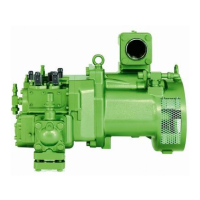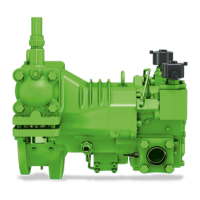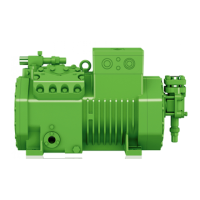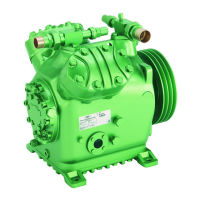20 ESB-130-3 RUS
ST-130-2
2
2 Functions
The OLC-D1-S can monitor either the
minimum or the maximum oil level,
depending on its mounting position
and incorporation into the safety
chain. If the minimum and the maxi-
mum oil level should be monitored,
two OLC-D1-S devices must be
installed.
2.1 Monitoring of the minimum
level
Lock out
The compressor is shut off, if the
prism sticks out of the oil longer than
the delay time specified by the circuit.
The OLC-D1-S then opens the output
contact and the circuit locks out elec-
tronically: The control voltage to the
compressor contactor is interrupted.
The red LED at the face side of the
opto-electronic unit lights up (figure 1)
as well as the signal lamp H4.
Reset
The circuit can be manually reset by
pressing the reset button. This reset
button (S4) has to be mounted into
the swich board. (Connection see
sche matic wiring diagram.)
2 Fonctionnement
Le OLC-D1-S peut contrôler soit le
niveau d'huile minimal soit le niveau
d'huile maximal, dépendant de la position
de montage et de l'intégration dans la
chaîne de sécurité. Pour surveiller le
niveau d'huile minimal et maximal en
même temps, deux OLC-D1-S doivent
être installés.
2.1 Contrôle du niveau d'huile minimal
Verrouiller
Le compresseur est arrêté des lors que le
temps pendant lequel le cône de verre
dépasse le niveau d'huile est supérieur à
la la temporisation prédéfinie par le
réglage.
Le OLC-D1-S ouvre alors le contact de
sortie et le circuit se verrouille électroni-
quement: la tension de commande du
con tacteur du compresseur est alors
coupée. La LED rouge sur le côté frontal
de l'unité opto-électronique s'allume (figu-
re 1) et ainsi que la lampe H4.
Déverrouiller
Le circuit peut être remis manuellement
en fonctionnement par la touche de reset.
Cette touche (S4) devra être montée
dans l'armoire électrique. (Raccordement
voir schéma de principe.)
2 Funktionen
Das OLC-D1-S kann entweder das
mini male oder das maximale Ölnive au
über wachen, je nach Montage-Posi ti -
on und Einbettung in die Sicher heits -
kette. Falls sowohl das mini male wie
das maximale Ölnive au über wacht
werden soll, müssen zwei OLC-D1-S
installiert werden.
2.1 Minimale Ölniveau-Überwa-
chung
Verriegeln
Der Verdichter wird abgeschaltet,
wenn der Glas-Kegel länger als die
durch die Schaltung vorgegebene Ver -
zöge rungs zeit aus dem Öl herausragt.
Das OLC-D1-S öffnet dann den Aus -
gangs kon takt und die Schaltung ver-
riegelt elektronisch: Die Steuerspan -
nung zum Verdich ter schütz wird unter-
brochen. Die rote LED auf der Stirn -
seite der opto-elektronischen Ein heit
(Abb. 1) und die Signallampe H4
leuchten.
Entriegeln
Die Schaltung kann über eine Reset-
Taste manuell zurück gesetzt werden.
Diese Reset-Taste (S4) muss im
Schalt schrank montiert werden.
(Anschluss siehe Prinzipschaltbild.)
Abb. 1 Abmessungen und Aufbau Fig. 1 Dimensions and design
Fig. 1 Dimensions et construction
1 Prisma-Einheit
2 Glas-Kegel
3 Dichtung
4 Opto-elektronische Einheit "OLC-D1"
(360° drehbar)
5 Anschlusskabel
6 Schraubkappe
1 Prism unit
2 Glass cone
3 Gasket
4 Opto-electronic unit "OLC-D1"
(360° revolving)
5 Connecting cable
6 Screwing cap
1 Unité prisme
2 Cône en verre
3 Joint
4 Composant opto-électronique "OLC-D1"
(mobile sur 360°)
5 Câble de raccordement
6 Chapeau à visser
5.6 Startvorgang
Drehrichtungprüfen
Achtung!
Gefahr von Verdichterausfall!
Scrollverdichter nur in der vor-
geschriebenen Drehrichtung
betreiben!
DrehrichtungstestohneSaug-
Absperrventil
• Magnetventil(Verdampfer)
schließen.
• VerdichternurfürwenigeSekunden
starten.
• RichtigeDrehrichtung:
Saugdruck sinkt ab.
• FalscheDrehrichtung:
Druck bleibt unverändert.
Wenn das Schutzgerät SE-E1 oder
SE-G1 eingebaut ist, schaltet es
den Verdichter ab.
Anschlussklemmen an gemein-
samer Zuleitung umpolen!
Schmierung/Ölkontrolle
• NachkurzzeitigemstabilemBetrieb,
Verdichter ausschalten und Ölstand
kontrollieren.
• ÖlstandmussimSchauglasbereich
liegen (wiederholte Kontrollen
innerhalb der ersten Betriebs-
stunden).
Wenn größere Ölmengen nachgefüllt
werden müssen:
Achtung!
Gefahr von Flüssigkeits-
schlägen!
Ölrückführung überprüfen.
5.6 Start-upprocedure
Checkingtherotatingdirection
Attention!
Danger of severe compressor
damage!
Operate scroll compressors
only in the prescribed rotating
direction!
Phasesequencetestwithout
suctionshut-offvalve
• Closethesolenoidvalve
(evaporator).
• Startthecompressorforafew
seconds only.
• Correctrotatingdirection:
Suction pressure drops.
• Wrongrotatingdirection:
Pressure remains constant.
If the protection device SE-E1 or
SE-G1 is installed, it shuts off the
compressor.
Change over two phases at the ter-
minals of the common supply line.
Lubrication/oilcheck
• Aftershort-termstableoperation,
switch-off compressor and check
oil level.
• Oillevelhastobewithinthesight
glass range (check again within first
operation hours).
If larger quantities of oil must be
added:
Attention!
Danger of liquid slugging!
Check the oil return.
5.6 Запуск компрессора
Проверка направления вращения
Внимание!
Опасность серьезного повреждения
компрессора!
Спиральные компрессоры
необходимо запускать только в
правильном направлении вращения!
Проверка правильности чередования
фаз без всасывающего запорного
клапана
• Отключите электромагнитный клапан
(испаритель).
• Запустите компрессор только на
несколько секунд.
• Правильное направление вращения:
Давление всасывания падает.
• Неправильное направление вращения:
Давление остается постоянным. Если
установлено защитное устройство
SE-E1 или SE-G1, то компрессор
отключится.
Поменяйте две фазы в контактах
общей питающей линии.
Проверка системы смазки / уровня
масла
• После кратковременной работы в
стабильном режиме, отключите ком-
прессор и проверьте уровень масла.
•
Уровень масла должен быть в пределах
смотрового стекла (повторно прове-
рьте в течение первых часов работы).
Если необходима дозаправка масла:
Внимание!
Опасность гидравлического удара!
Проверьте возврат масла.
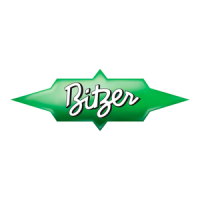
